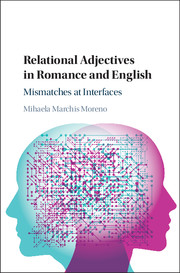Book contents
- Relational Adjectives in Romance and English
- Relational Adjectives in Romance and English
- Copyright page
- Contents
- Tables
- 1 Introduction
- 2 What does Morphology Learn from Relational Adjectives?
- 3 Ontological Semantics: Qualifying versus Relational Adjectives
- 4 A Classification of Relational Adjectives across Languages
- 5 The Morpho-syntactic Analysis of Relational Adjectives
- 6 The Syntax of Thematic Adjectives
- 7 Deverbal Nominalizations
- 8 Thematic Adjectives and Nominalizations
- 9 The Syntax of Classificatory Adjectives
- 10 Relational Adjectives as Compounding
- 11 Conclusions and Questions for Further Research
- References
- Index
5 - The Morpho-syntactic Analysis of Relational Adjectives
Published online by Cambridge University Press: 18 April 2018
- Relational Adjectives in Romance and English
- Relational Adjectives in Romance and English
- Copyright page
- Contents
- Tables
- 1 Introduction
- 2 What does Morphology Learn from Relational Adjectives?
- 3 Ontological Semantics: Qualifying versus Relational Adjectives
- 4 A Classification of Relational Adjectives across Languages
- 5 The Morpho-syntactic Analysis of Relational Adjectives
- 6 The Syntax of Thematic Adjectives
- 7 Deverbal Nominalizations
- 8 Thematic Adjectives and Nominalizations
- 9 The Syntax of Classificatory Adjectives
- 10 Relational Adjectives as Compounding
- 11 Conclusions and Questions for Further Research
- References
- Index
Summary
- Type
- Chapter
- Information
- Relational Adjectives in Romance and EnglishMismatches at Interfaces, pp. 57 - 83Publisher: Cambridge University PressPrint publication year: 2018

